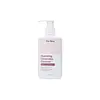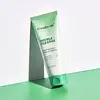What's inside
What's inside
 Key Ingredients
Key Ingredients

 Benefits
Benefits

 Concerns
Concerns

 Ingredients Side-by-side
Ingredients Side-by-side

Water
Skin ConditioningDisodium Laureth Sulfosuccinate
CleansingCetyl Alcohol
EmollientPropylene Glycol
HumectantGlyceryl Stearate
EmollientPEG-100 Stearate
Niacinamide
SmoothingSqualane
EmollientButylene Glycol
HumectantCeramide NP
Skin ConditioningCeramide Ns
Skin ConditioningCeramide As
Skin ConditioningCeramide AP
Skin ConditioningCeramide EOP
Skin ConditioningHydrolyzed Centella Asiatica Extract
AntioxidantCamellia Sinensis Leaf Extract
AntimicrobialPolygonum Cuspidatum Root Extract
AntioxidantScutellaria Baicalensis Root Extract
AstringentGlycyrrhiza Glabra Root Extract
BleachingChamomilla Recutita Flower Extract
MaskingRosmarinus Officinalis Leaf Extract
AntimicrobialDipotassium Glycyrrhizate
HumectantSodium Hyaluronate
HumectantPanthenol
Skin ConditioningCholesterol
EmollientHydrogenated Lecithin
EmulsifyingAlpha-Glucan Oligosaccharide
CleansingCaprylyl Glycol
Emollient1,2-Butanediol
HumectantDipropylene Glycol
HumectantHydroxyacetophenone
AntioxidantPhenoxyethanol
PreservativeEthylhexylglycerin
Skin ConditioningWater, Disodium Laureth Sulfosuccinate, Cetyl Alcohol, Propylene Glycol, Glyceryl Stearate, PEG-100 Stearate, Niacinamide, Squalane, Butylene Glycol, Ceramide NP, Ceramide Ns, Ceramide As, Ceramide AP, Ceramide EOP, Hydrolyzed Centella Asiatica Extract, Camellia Sinensis Leaf Extract, Polygonum Cuspidatum Root Extract, Scutellaria Baicalensis Root Extract, Glycyrrhiza Glabra Root Extract, Chamomilla Recutita Flower Extract, Rosmarinus Officinalis Leaf Extract, Dipotassium Glycyrrhizate, Sodium Hyaluronate, Panthenol, Cholesterol, Hydrogenated Lecithin, Alpha-Glucan Oligosaccharide, Caprylyl Glycol, 1,2-Butanediol, Dipropylene Glycol, Hydroxyacetophenone, Phenoxyethanol, Ethylhexylglycerin
Water
Skin ConditioningGlycerin
HumectantPalmitic Acid
EmollientLauric Acid
CleansingStearic Acid
CleansingMyristic Acid
CleansingPotassium Hydroxide
BufferingCocamidopropyl Betaine
CleansingPEG-100 Stearate
Glyceryl Stearate
EmollientBeeswax
Emulsion StabilisingGlycol
HumectantEthylhexylglycerin
Skin ConditioningPolyquaternium-10
Capric Acid
CleansingDisodium EDTA
Aloe Barbadensis Leaf Extract
EmollientOryza Sativa Extract
AbsorbentCamellia Sinensis Leaf Extract
Antimicrobial1,2-Hexanediol
Skin ConditioningHydrogenated Lecithin
EmulsifyingPolyglyceryl-10 Stearate
Skin ConditioningLilium Tigrinum Root Extract
HumectantPanthenol
Skin ConditioningSodium Hyaluronate
HumectantSodium Ascorbyl Phosphate
AntioxidantHydroxypropyltrimonium Hyaluronate
Niacinamide
SmoothingHydrolyzed Hyaluronic Acid
HumectantPyridoxine
Skin ConditioningFolic Acid
Skin ConditioningSodium Acetylated Hyaluronate
HumectantBiotin
AntiseborrhoeicHyaluronic Acid
HumectantHydrolyzed Sodium Hyaluronate
Skin ConditioningTocopherol
AntioxidantSodium Hyaluronate Crosspolymer
HumectantCyanocobalamin
Skin ConditioningPotassium Hyaluronate
Skin ConditioningThiamine Hcl
MaskingBeta-Carotene
Skin ConditioningRiboflavin
Cosmetic ColorantLinoleic Acid
CleansingParfum
MaskingWater, Glycerin, Palmitic Acid, Lauric Acid, Stearic Acid, Myristic Acid, Potassium Hydroxide, Cocamidopropyl Betaine, PEG-100 Stearate, Glyceryl Stearate, Beeswax, Glycol, Ethylhexylglycerin, Polyquaternium-10, Capric Acid, Disodium EDTA, Aloe Barbadensis Leaf Extract, Oryza Sativa Extract, Camellia Sinensis Leaf Extract, 1,2-Hexanediol, Hydrogenated Lecithin, Polyglyceryl-10 Stearate, Lilium Tigrinum Root Extract, Panthenol, Sodium Hyaluronate, Sodium Ascorbyl Phosphate, Hydroxypropyltrimonium Hyaluronate, Niacinamide, Hydrolyzed Hyaluronic Acid, Pyridoxine, Folic Acid, Sodium Acetylated Hyaluronate, Biotin, Hyaluronic Acid, Hydrolyzed Sodium Hyaluronate, Tocopherol, Sodium Hyaluronate Crosspolymer, Cyanocobalamin, Potassium Hyaluronate, Thiamine Hcl, Beta-Carotene, Riboflavin, Linoleic Acid, Parfum
 Reviews
Reviews

Ingredients Explained
These ingredients are found in both products.
Ingredients higher up in an ingredient list are typically present in a larger amount.
Camellia Sinensis Leaf Extract is derived from the leaves of the tea plant. Black tea, green tea, and oolong tea are all harvested from this plant.
This ingredient has many skin benefits:
This ingredient contains polyphenols, a strong antioxidant. Antioxidants help fight off molecules that damage skin cells.
On top of that, the antioxidants in green tea neutralize free-radicals from the sun. This gives the skin some extra UV protection, but should not replace sunscreen.
Many components of tea have anti-inflammatory properties.
Polyphenols and L-theanine help soothe the skin and reduce irritation. The caffeine in Camellia Sinensis Leaf Extract helps calm inflamed blood vessels.
Other compounds found in tea include: Vitamin Bs, linoleic acid, magnesium, calcium, iron, and zinc.
Research has shown both drinking Camellia Sinensis Leaf Tea and applying it to the skin can help boost skin elasticity and hydration. Studies also show using tea extract may reduce sebum, or oil, production.
Learn more about Camellia Sinensis Leaf ExtractEthylhexylglycerin (we can't pronounce this either) is commonly used as a preservative and skin softener. It is derived from glyceryl.
You might see Ethylhexylglycerin often paired with other preservatives such as phenoxyethanol. Ethylhexylglycerin has been found to increase the effectiveness of these other preservatives.
Glyceryl Stearate is a mix of glycerin and stearic acid.
It is used to stabilize the mixing of water and oil ingredients. By preventing these ingredients from separating, it can help elongate shelf life. It can also help thicken the product's texture.
As an emollient, it helps soften skin and supports barrier-replenishing ingredients.
In cosmetics, Glyceryl Stearate is often made from vegetable oils or synthetically produced.
This ingredient may not be fungal-acne safe
Fun fact: The human body also creates Glyceryl Stearate naturally.
Learn more about Glyceryl StearateHydrogenated Lecithin is created from the hydrogenation of lecithin (a group of phospholipids). Hydrogenation is a chemical reaction between hydrogen and another element.
This ingredient is an emollient and emulsifier. As an emollient, it helps soften skin by trapping moisture within. As an emulsifier, it prevents oil and water ingredients from separating.
Niacinamide is a multitasking form of vitamin B3 that strengthens the skin barrier, reduces pores and dark spots, regulates oil, and improves signs of aging.
And the best part? It's gentle and well-tolerated by most skin types, including sensitive and reactive skin.
You might have heard of "niacin flush", or the reddening of skin that causes itchiness. Niacinamide has not been found to cause this.
In very rare cases, some individuals may not be able to tolerate niacinamide at all or experience an allergic reaction to it.
If you are experiencing flaking, irritation, and dryness with this ingredient, be sure to double check all your products as this ingredient can be found in all categories of skincare.
When incorporating niacinamide into your routine, look out for concentration amounts. Typically, 5% niacinamide provides benefits such as fading dark spots. However, if you have sensitive skin, it is better to begin with a smaller concentration.
When you apply niacinamide to your skin, your body converts it into nicotinamide adenine dinucleotide (NAD). NAD is an essential coenzyme that is already found in your cells as "fuel" and powers countless biological processes.
In your skin, NAD helps repair cell damage, produce new healthy cells, support collagen production, strengthen the skin barrier, and fight environmental stressors (like UV and pollution).
Our natural NAD levels start to decline with age, leading to slower skin repair, visible aging, and a weaker skin barrier. By providing your skin niacinamide, you're recharging your skin's NAD levels. This leads to stronger, healthier, and younger looking skin.
Another name for vitamin B3 is nicotinamide. This vitamin is water-soluble and our bodies don't store it. We obtain Vitamin B3 from either food or skincare. Meat, fish, wheat, yeast, and leafy greens contain vitamin B3.
The type of niacinamide used in skincare is synthetically created.
Learn more about NiacinamidePanthenol is a common ingredient that helps hydrate and soothe the skin. It is found naturally in our skin and hair.
There are two forms of panthenol: D and L.
D-panthenol is also known as dexpanthenol. Most cosmetics use dexpanthenol or a mixture of D and L-panthenol.
Panthenol is famous due to its ability to go deeper into the skin's layers. Using this ingredient has numerous pros (and no cons):
Like hyaluronic acid, panthenol is a humectant. Humectants are able to bind and hold large amounts of water to keep skin hydrated.
This ingredient works well for wound healing. It works by increasing tissue in the wound and helps close open wounds.
Once oxidized, panthenol converts to pantothenic acid. Panthothenic acid is found in all living cells.
This ingredient is also referred to as pro-vitamin B5.
Learn more about PanthenolPeg-100 Stearate is an emollient and emulsifier. As an emollient, it helps keep skin soft by trapping moisture in. On the other hand, emulsifiers help prevent oil and water from separating in a product.
PEGS are a hydrophilic polyether compound . There are 100 ethylene oxide monomers in Peg-100 Stearate. Peg-100 Stearate is polyethylene glycol ester of stearic acid.
Sodium Hyaluronate is hyaluronic acid's salt form. It is commonly derived from the sodium salt of hyaluronic acid.
Like hyaluronic acid, it is great at holding water and acts as a humectant. This makes it a great skin hydrating ingredient.
Sodium Hyaluronate is naturally occurring in our bodies and is mostly found in eye fluid and joints.
These are some other common types of Hyaluronic Acid:
Learn more about Sodium HyaluronateWater. It's the most common cosmetic ingredient of all. You'll usually see it at the top of ingredient lists, meaning that it makes up the largest part of the product.
So why is it so popular? Water most often acts as a solvent - this means that it helps dissolve other ingredients into the formulation.
You'll also recognize water as that liquid we all need to stay alive. If you see this, drink a glass of water. Stay hydrated!
Learn more about Water